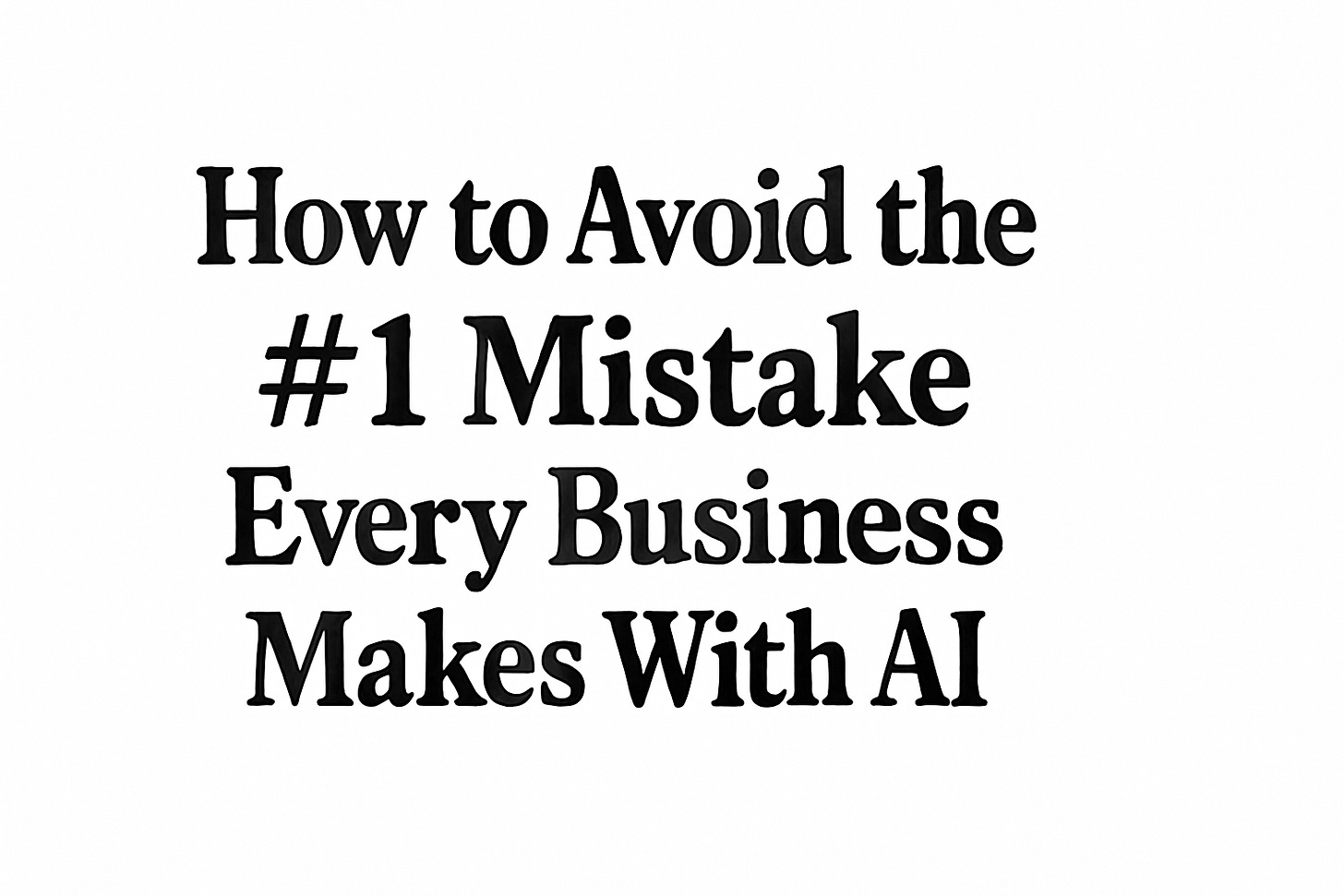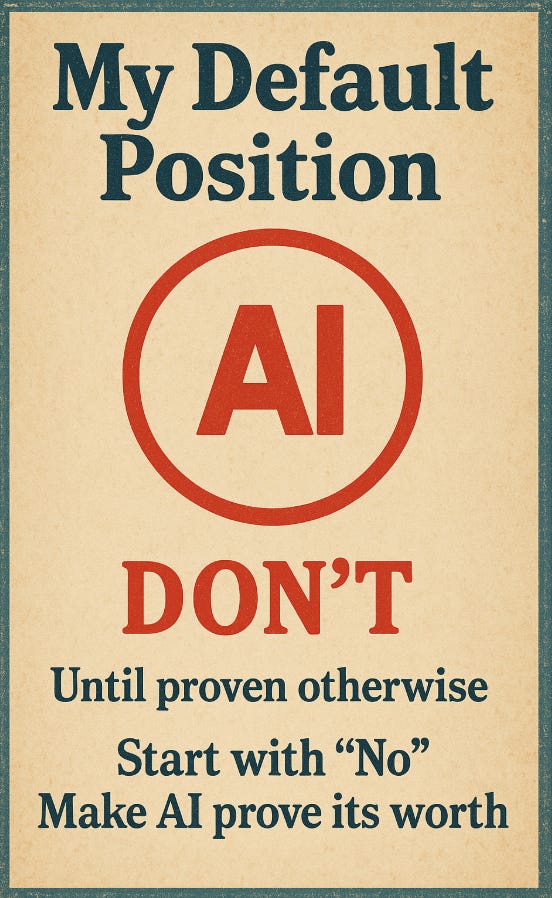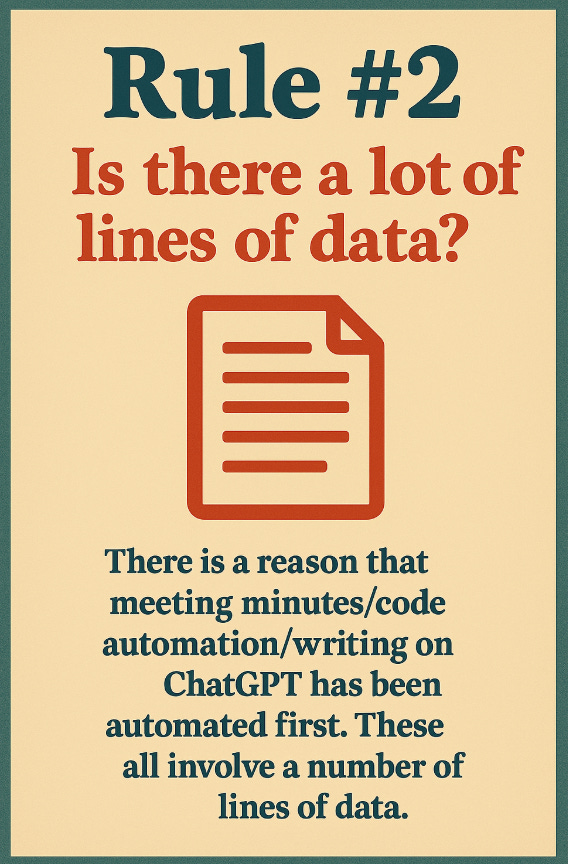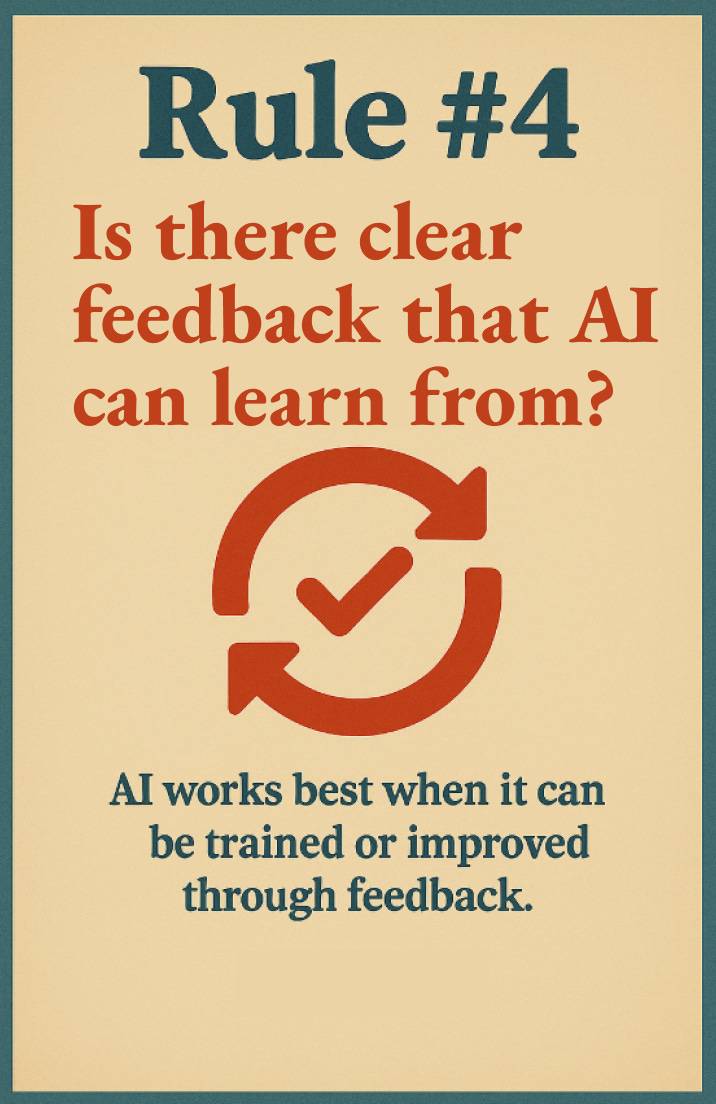How to Avoid the #1 Mistake Every Business Makes With AI
Helping you to navigate between the hype and reality of where AI can be helpful
When evaluating a patient, a doctor is taught to consider common conditions before rare ones because “common things are common.”
So if you are young and have chest pain - they look for more common things first, like anxiety, muscle strain or acid reflux, before jumping to a heart attack.
AI is the same and here is my default position.
As an AI consultant, my first instinct is not to jump to AI as the first solution for a business.
In fact a number of common solutions can usually help solve the problem first.
This is the most common mistake I see businesses make.
Here are 4 simple rules that will give you a compass to know when something is worth using AI for.
Rule #1 - Do you do this task often?
Daily or weekly is usually good enough.
If it’s weekly then I would go to the second point
Rule #2 - Do you need to generate a lot of data?
There is a reason that meeting minutes/code automation/writing on ChatGPT has been automated first. These all involve a large number of lines of data.
Compare that to
‘What price should I charge for my product?’
Rule #3 – Is the cost of being wrong low enough?
AI will be wrong. That’s a given. So the key question becomes: what happens when it is?
If you’re generating marketing headline variations or recommending internal documentation, there is a low cost of error. Go for it.
If you’re auto-approving loans or diagnosing cancer? You’d better be extremely cautious.
A great AI candidate is where the cost of being wrong is small, or where human review can catch mistakes before they matter.
Rule #4 – Is there clear feedback or a loop to learn from
AI works best when it can be trained or improved through feedback. That’s why email spam filters got good early. There’s constant feedback — did the user click “mark as spam” or not?
If your business problem has no clear signal or feedback loop — like figuring out a brand strategy — then AI is going to struggle. It doesn’t know what “good” looks like unless you define it.
On the flip side, if you're processing thousands of support tickets and you consistently tag them or resolve them a certain way, there's learning there. That’s where AI can shine.
The Wildcard Rule - Does it allow you to do something you aren’t currently doing
This rule has some nuance to it. AI has brought about some new benefits that never existed before. For example it is much better at analysing your existing data and finding things you didn’t know.
As a result, data ingestion and analysis projects usually help in some way as they are a new paradigm shift.
My test for the wildcard rule is:
What new capability does it unlock?
Can you prove it in a small manual test first? In the data scraping example, if you have 5000 projects, start with 5.
Assume I clicked my finger and gave you what you wanted with AI. What would you do with that?
The 30-Second AI Decision Test
Before you invest a single dollar in AI, run this expanded test:
Count your rows: How much data are you actually generating?
Time the manual process: How long does it currently take a human?
Calculate frequency: How often do you need to do this task?
Ask the expansion question: "Could AI help us do something we've never been able to do before?"
Evaluate the impossibility factor: "Is this humanly possible at our current scale and budget?"
If your answers are "under 100 lines," "less than an hour," "monthly," AND "this is just faster automation," congratulations—you just saved yourself months of development time and thousands of dollars.
But if AI would give you new capabilities or insights that are currently impossible, the calculation changes completely.
Let’s put this into practice
Personal Tasks
Autocomplete text (e.g. Gmail Smart Compose) — ✅ Use AI: frequent task, low risk, strong feedback loop.
Meal plan generator — ⚠️ Optional AI: used weekly, low data, limited feedback, not mission-critical.
Travel itinerary planning — ⚠️ Optional AI: medium use case, some novelty, but low feedback and small data. Also high downside if it makes bad recommendations.
Budgeting assistant — ✅ Use AI: weekly use, structured data, clear feedback from transactions.
Business Tasks
Meeting transcription (Otter, Fireflies) — ✅ Use AI: high frequency, large data, low risk, easy to verify.
Code completion (Cursor) — ✅ Use AI: constant use, lots of code, undoable, low risk.
Support ticket classification — ✅ Use AI: high volume, labelled data, feedback built-in.
Predicting pricing strategy — ❌ Skip AI: strategic decision, limited data, high risk if wrong.
Legal document review — ⚠️ Use AI with humans: high data volume but high cost if wrong — needs oversight.
Internal knowledge search (e.g. Glean) — ✅ Use AI: frequent, massive data, clear ROI.
Branding or company mission creation — ❌ Skip AI: no data, no feedback, highly strategic.
Data scraping from public sources — ✅ Use AI: scale impossible manually, medium risk, easy to test.
Invoice approval automation — ❌ Skip AI: high consequence if wrong, often better with rules or workflow logic.
Thanks to Mark for the question for this week. I love writing articles in response to questions so please feel free to message me or email yours.
Other articles I wrote this week
Share With Decision Makers
If you found this valuable, would you mind sharing it with one colleague who's considering AI? They'll thank you for saving them from expensive mistakes







